Unit 3 Look at my nose 说课课件
文档属性
| 名称 | Unit 3 Look at my nose 说课课件 | 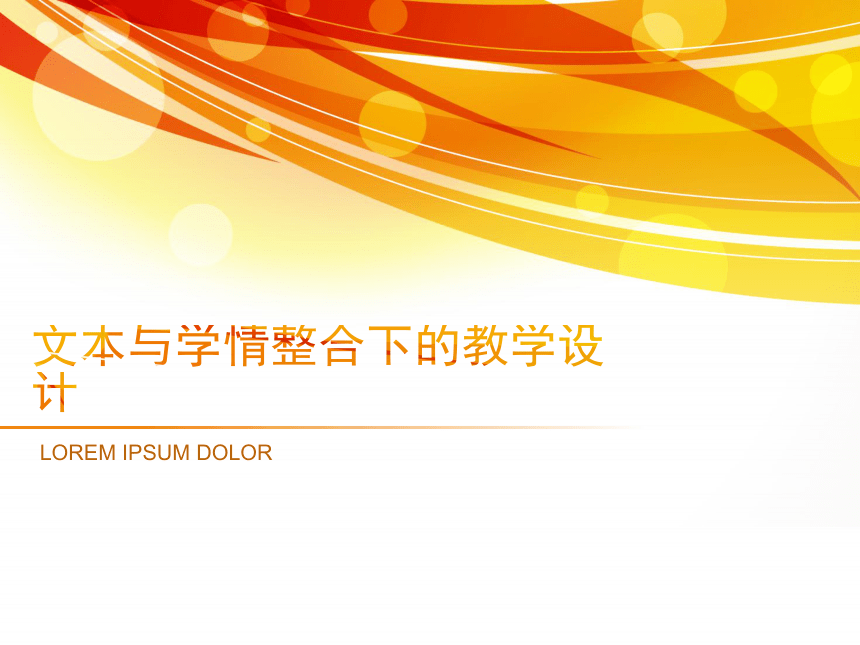 | |
| 格式 | zip | ||
| 文件大小 | 574.9KB | ||
| 资源类型 | 教案 | ||
| 版本资源 | 人教精通版(三年级起点) | ||
| 科目 | 英语 | ||
| 更新时间 | 2017-05-16 10:31:55 | ||
图片预览

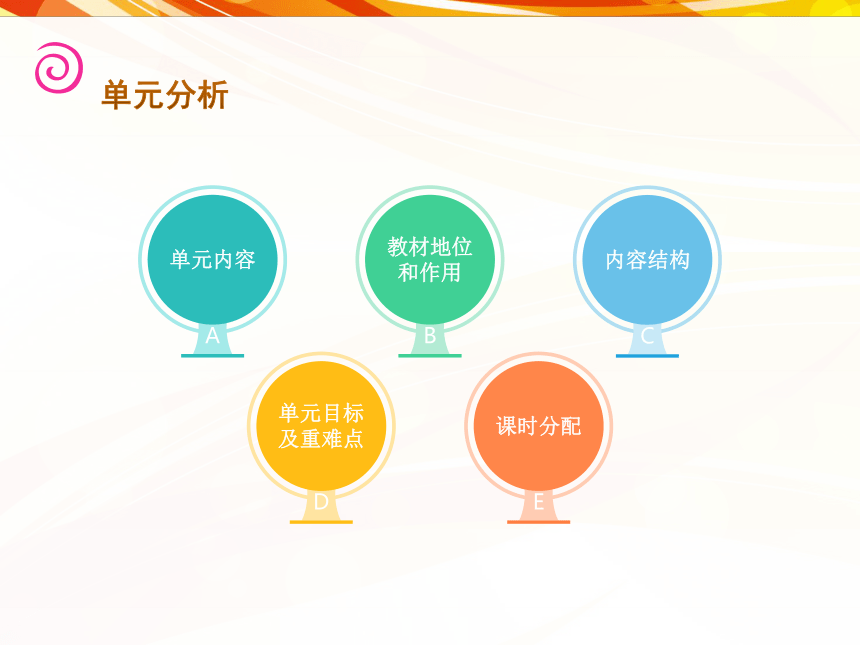
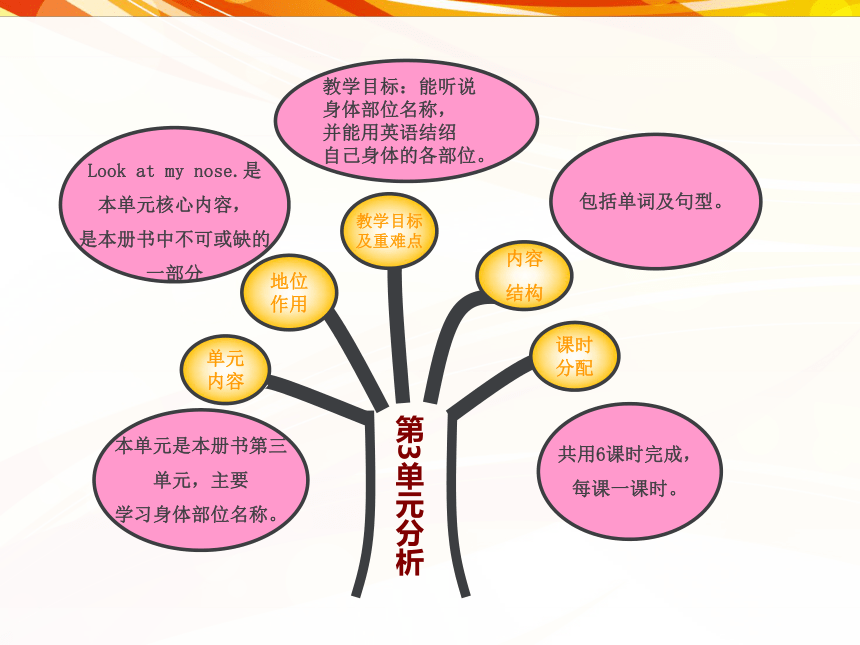
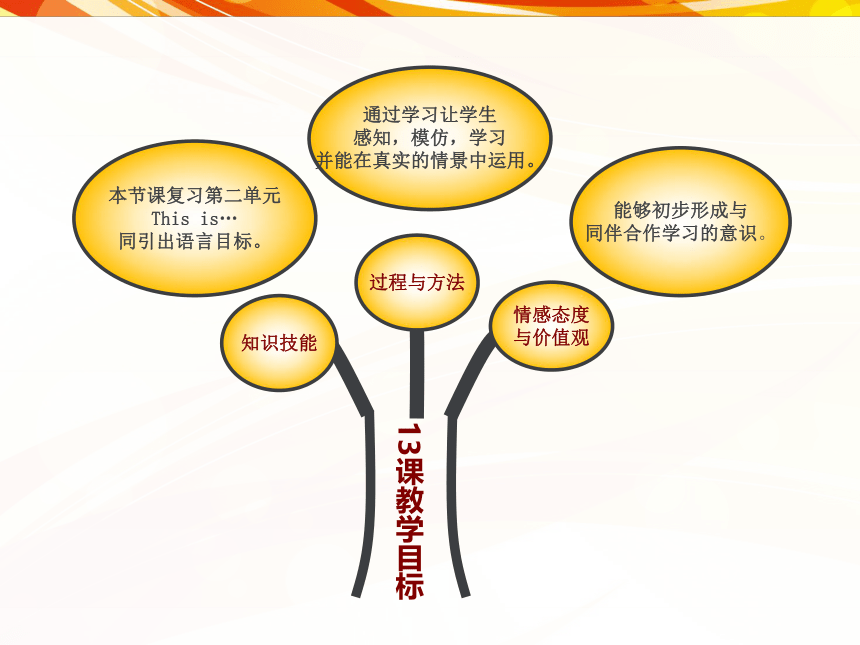
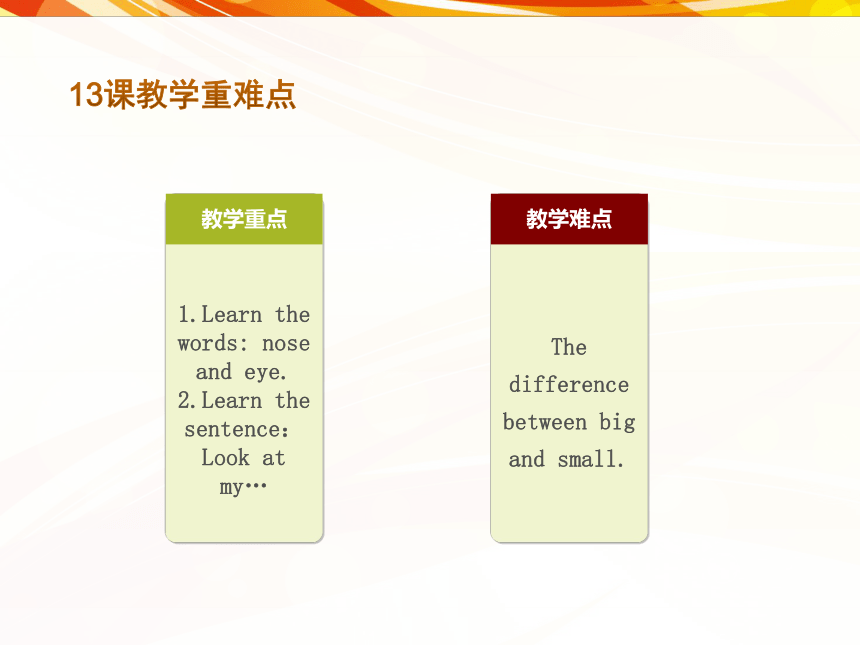

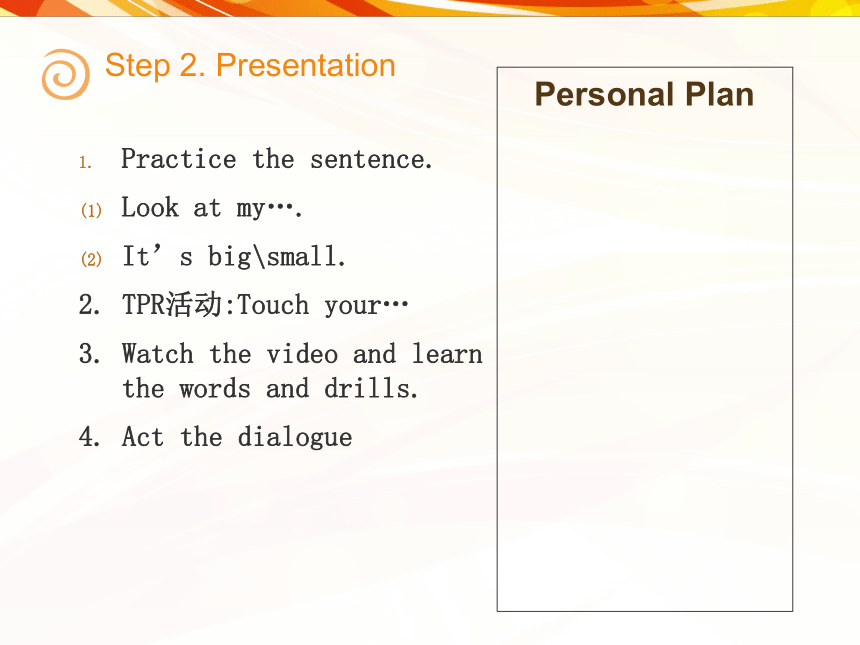
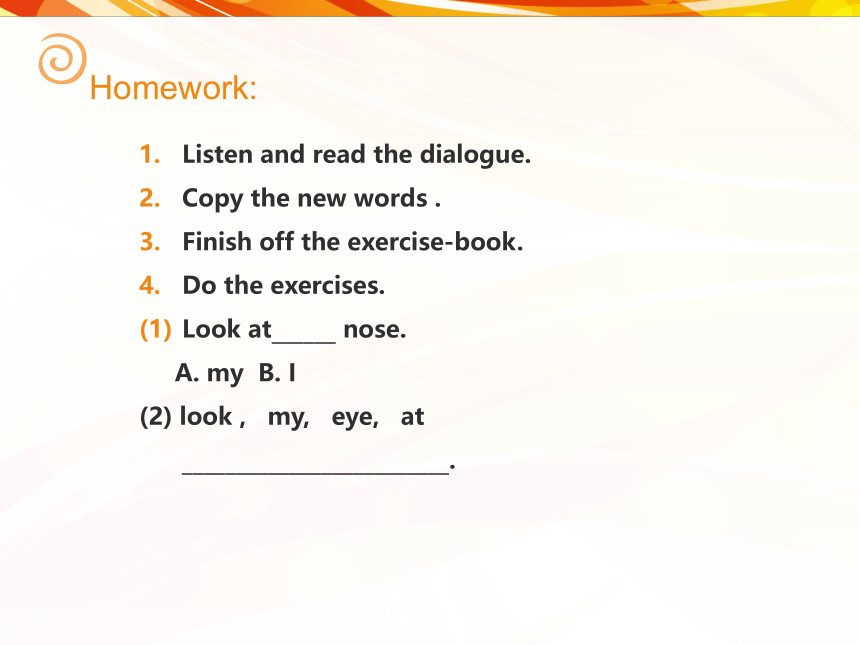



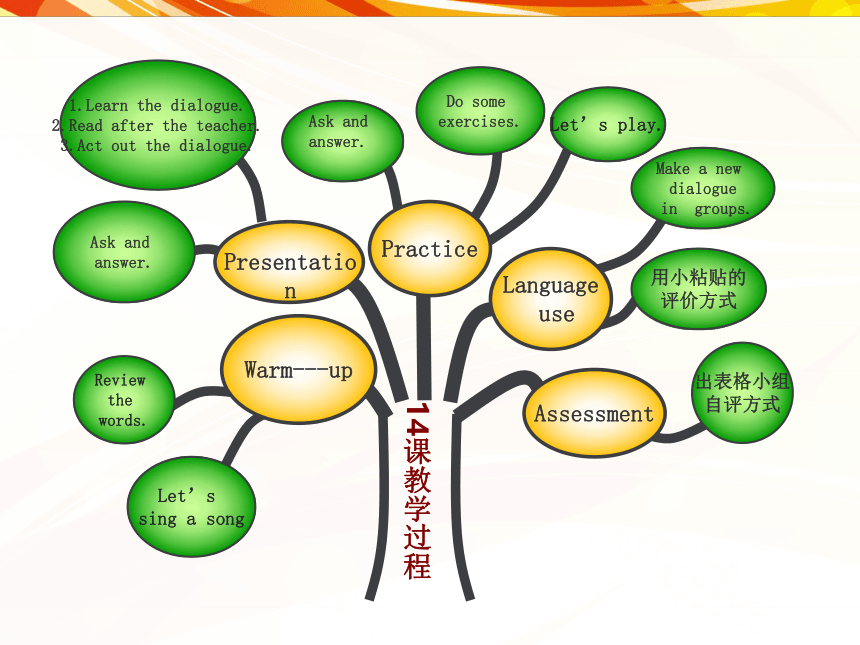
文档简介
课件39张PPT。文本与学情整合下的教学设计LOREM IPSUM DOLOR 单元分析E课时分配C内容结构B教材地位和作用A单元内容D单元目标及重难点地位
作用课时
分配内容
结构教学目标
及重难点第3单元分析单元
内容
教学目标:能听说
身体部位名称,
并能用英语结绍
自己身体的各部位。
包括单词及句型。共用6课时完成,
每课一课时。
Look at my nose.是
本单元核心内容,
是本册书中不可或缺的
一部分本单元是本册书第三
单元,主要
学习身体部位名称。知识技能情感态度
与价值观过程与方法13课教学目标本节课复习第二单元
This is…
同引出语言目标。
通过学习让学生
感知,模仿,学习
并能在真实的情景中运用。
能够初步形成与
同伴合作学习的意识。1.Learn the words: nose and eye.
2.Learn the sentence:Look at my…教学重点The difference between big and small.教学难点13课教学重难点Warm---upPractice
Make a new
chant.
Answer
questions复习第二单元
单词。Assessment手拉手,交朋友
的评价方式出表格小组
自评方式Language
useAsk and
answer.1. Learn the words
2.Read after the teacher.
3.Act out the dialogues.Make a new
dialogue
in groups.Let’s
play game.
Let’s sing a song.13课教学过程
Presentation Step 2. PresentationPractice the sentence.
Look at my….
It’s bigsmall.
2. TPR活动:Touch your…
3. Watch the video and learn the words and drills.
4. Act the dialogue Personal Plan Homework:Listen and read the dialogue.
Copy the new words .
Finish off the exercise-book.
Do the exercises.
Look at______ nose.
A. my B. I
(2) look , my, eye, at
_________________________. 学情分析:教学反思:知识技能情感态度
与价值观过程与方法14课教学目标本节课学习face,mouth
及句型。
通过学习让学生
感知,模仿,学习
并能在真实的情景中运用。
能够初步形成与
同伴合作学习的意识。1.Learn the words:
face and mouth.
2.Learn how to use the sentences:
How are you?
Fine, thank you!教学重点He has a big face.教学难点14课教学重难点Warm---upPracticeAsk and
answer.
Do some
exercises.
Review
the
words.Assessment用小粘贴的
评价方式出表格小组
自评方式Language
useAsk and
answer.1.Learn the dialogue.
2.Read after the teacher.
3.Act out the dialogue.Make a new
dialogue
in groups.Let’s play.Let’s
sing a song14课教学过程
Presentation Step 2. PresentationAsk and answer : How are you? Fine , thank you!
Practice the sentences:
Look at my…
He has a big/ small…..
3. TPR活动:Touch your…
4. Watch the video and learn the words and drills.
5. Act the dialogue.
Personal Plan Homework:Listen and read the dialogue.
Copy the new words .
Finish off the exercise-book.
Do the exercises.
How are you?________.
A. Hello. B. Fine, thank you!
(2) has , he, a, face, big
_________________________. 学情分析:教学反思:知识技能情感态度
与价值观过程与方法15课教学目标本节课学习head,ear
及句型。通过学习让学生
感知,模仿,学习
并能在真实的情景中运用。能够初步形成与
同伴合作学习的意识。1.Learn the new words:
head and ear.
2.Learn how to use the sentences:
How are you?
Good, and you?
I’m fine . Thanks.教学重点How are you?
Good, and you?
I’m fine. Thanks教学难点15课教学重难点Warm---upPracticeAsk and
answer. Do some
exercises.Review
the
words.
Assessment按学生表现
贴苹果Language useLearn
the words.1.Learn the dialogue.
2.Read after the teacher.
3.Act out the dialogue.Let’s sing.Let’s chant. 15课教学过程Presentation Step 2. PresentationAsk and answer : How are you? Fine , thank you!
Good ,and you? I’m fine thanks.
2. TPR活动:Touch your…
3. Watch the video and learn the words and drills.
4. Act the dialogue.
5.Let’s sing.
Personal Plan Homework:Listen and read the dialogue.
Copy the new words .
Finish off the exercise-book.
Do the exercises.
____________? Good! And you?
A. How are you? B. What’s your name?
(2) fine , I, am
_________________________. 学情分析:教学反思:知识技能情感态度
与价值观过程与方法16课教学目标本节课学习
neck,arm,hand
及句型。通过学习让学生
感知,模仿,学习
并能在真实的情景中运用。
能够初步形成与
同伴合作学习的意识。1.Learn the words:neck and arm,hand.
2.Learn the sentences:
How are you?
Not very well.教学重点How are you?
Not very well.教学难点16课教学重难点Warm---upPractice
Make a new
chant.
Let’s do.
Watch the flash
Act out
the dialogue.
Review
the words.
Assessment奖励数字
小粘贴Language useAsk and
answer.1.Learn the dialogue.
2.Read after the teacher.Let’s play.
Let’s chant.
16课教学过程PresentationMake a new
dialogue
in groups. Step 2. PresentationAsk and answer : How are you? Fine , thank you!
Not very well. Look at my…. I’m sorry.
2. TPR活动:Touch your…
3. Watch the video and learn the words and drills.
4. Act the dialogue.
5.Let’s do.
Personal Plan Homework:Listen and read the dialogue.
Copy the new words .
Finish off the exercise-book.
Do the exercises.
Look at my arm!__________.
A. Thank you! B. Oh,I’m sorry!
(2)译成中文.
Not very well.______________________. 学情分析:教学反思:知识技能情感态度
与价值观过程与方法17课教学目标本节课学习leg,knee,foot
及句型。通过学习让学生
感知,模仿,学习
并能在真实的情景中运用。能够初步形成与
同伴合作学习的意识。1.Learn the words:leg,knee,foot.
2.Learn how to use the sentences:
How are you?
Not so well.教学重点How are you?
Not so well.教学难点17课教学重难点Warm---upPracticeLet’s sing.Do some
exercises.
Play a game.
Assessment奖励数字
小粘贴Language useLearn the words.Ask and
answer.Let’s
sing a song.17课教学过程PresentationMake a new
dialogue.1.Learn the dialogue.
2.Read after the teacher.
3.Act out the dialogue.
Step 2. PresentationAsk and answer : How are you? Fine , thank you!
Not so well. Look at my…. I’m sorry.
2. TPR活动:Touch your…
3. Watch the video and learn the words and drills.
4. Act the dialogue.
5.Let’s sing.
Personal Plan Homework:Listen and read the dialogue.
Copy the new words .
Finish off the exercise-book.
Do the exercises.
How are you?________.
A. Not so well. B. I’m Peter.
(2) look , my, leg, at
____________________________. 学情分析:教学反思:知识技能情感态度
与价值观过程与方法18课教学目标本节课在复习本单元单词及
句型的基础上学习Fun story.通过学习让学生
感知,模仿,学习
并能在真实的情景中运用。能够初步形成与
同伴合作学习的意识。Revise the words and sentences:ears, nose,
hand, foot.
Look at the……教学重点本单元重点知识的归纳与总结。教学难点18课教学重难点Warm---upPractice
Ask and
answer
Watch
the flash
Act out
the dialogue.Let’s
play games.Assessment最佳发音奖
最佳导演奖Language useReview
the words.1.Learn the dialogue.
2.Read after the teacher.
3.Act out the dialogue.Do some
exercises.Let’s play.Let’s
sing a song18课教学过程
Presentation
Revise the
sentences
Step 2. Presentation1. Play a game:Show me your……
2. Watch the video and learn the dialogue.
3. Act the dialogue.
Personal Plan Homework:Listen and read the dialogue.
Copy the new words .
Finish off the exercise-book.
Do the exercises.
Look at the_______ .
A. ears B. ear
(2) look , the, hand, at
____________________________! 学情分析:教学反思:
作用课时
分配内容
结构教学目标
及重难点第3单元分析单元
内容
教学目标:能听说
身体部位名称,
并能用英语结绍
自己身体的各部位。
包括单词及句型。共用6课时完成,
每课一课时。
Look at my nose.是
本单元核心内容,
是本册书中不可或缺的
一部分本单元是本册书第三
单元,主要
学习身体部位名称。知识技能情感态度
与价值观过程与方法13课教学目标本节课复习第二单元
This is…
同引出语言目标。
通过学习让学生
感知,模仿,学习
并能在真实的情景中运用。
能够初步形成与
同伴合作学习的意识。1.Learn the words: nose and eye.
2.Learn the sentence:Look at my…教学重点The difference between big and small.教学难点13课教学重难点Warm---upPractice
Make a new
chant.
Answer
questions复习第二单元
单词。Assessment手拉手,交朋友
的评价方式出表格小组
自评方式Language
useAsk and
answer.1. Learn the words
2.Read after the teacher.
3.Act out the dialogues.Make a new
dialogue
in groups.Let’s
play game.
Let’s sing a song.13课教学过程
Presentation Step 2. PresentationPractice the sentence.
Look at my….
It’s bigsmall.
2. TPR活动:Touch your…
3. Watch the video and learn the words and drills.
4. Act the dialogue Personal Plan Homework:Listen and read the dialogue.
Copy the new words .
Finish off the exercise-book.
Do the exercises.
Look at______ nose.
A. my B. I
(2) look , my, eye, at
_________________________. 学情分析:教学反思:知识技能情感态度
与价值观过程与方法14课教学目标本节课学习face,mouth
及句型。
通过学习让学生
感知,模仿,学习
并能在真实的情景中运用。
能够初步形成与
同伴合作学习的意识。1.Learn the words:
face and mouth.
2.Learn how to use the sentences:
How are you?
Fine, thank you!教学重点He has a big face.教学难点14课教学重难点Warm---upPracticeAsk and
answer.
Do some
exercises.
Review
the
words.Assessment用小粘贴的
评价方式出表格小组
自评方式Language
useAsk and
answer.1.Learn the dialogue.
2.Read after the teacher.
3.Act out the dialogue.Make a new
dialogue
in groups.Let’s play.Let’s
sing a song14课教学过程
Presentation Step 2. PresentationAsk and answer : How are you? Fine , thank you!
Practice the sentences:
Look at my…
He has a big/ small…..
3. TPR活动:Touch your…
4. Watch the video and learn the words and drills.
5. Act the dialogue.
Personal Plan Homework:Listen and read the dialogue.
Copy the new words .
Finish off the exercise-book.
Do the exercises.
How are you?________.
A. Hello. B. Fine, thank you!
(2) has , he, a, face, big
_________________________. 学情分析:教学反思:知识技能情感态度
与价值观过程与方法15课教学目标本节课学习head,ear
及句型。通过学习让学生
感知,模仿,学习
并能在真实的情景中运用。能够初步形成与
同伴合作学习的意识。1.Learn the new words:
head and ear.
2.Learn how to use the sentences:
How are you?
Good, and you?
I’m fine . Thanks.教学重点How are you?
Good, and you?
I’m fine. Thanks教学难点15课教学重难点Warm---upPracticeAsk and
answer. Do some
exercises.Review
the
words.
Assessment按学生表现
贴苹果Language useLearn
the words.1.Learn the dialogue.
2.Read after the teacher.
3.Act out the dialogue.Let’s sing.Let’s chant. 15课教学过程Presentation Step 2. PresentationAsk and answer : How are you? Fine , thank you!
Good ,and you? I’m fine thanks.
2. TPR活动:Touch your…
3. Watch the video and learn the words and drills.
4. Act the dialogue.
5.Let’s sing.
Personal Plan Homework:Listen and read the dialogue.
Copy the new words .
Finish off the exercise-book.
Do the exercises.
____________? Good! And you?
A. How are you? B. What’s your name?
(2) fine , I, am
_________________________. 学情分析:教学反思:知识技能情感态度
与价值观过程与方法16课教学目标本节课学习
neck,arm,hand
及句型。通过学习让学生
感知,模仿,学习
并能在真实的情景中运用。
能够初步形成与
同伴合作学习的意识。1.Learn the words:neck and arm,hand.
2.Learn the sentences:
How are you?
Not very well.教学重点How are you?
Not very well.教学难点16课教学重难点Warm---upPractice
Make a new
chant.
Let’s do.
Watch the flash
Act out
the dialogue.
Review
the words.
Assessment奖励数字
小粘贴Language useAsk and
answer.1.Learn the dialogue.
2.Read after the teacher.Let’s play.
Let’s chant.
16课教学过程PresentationMake a new
dialogue
in groups. Step 2. PresentationAsk and answer : How are you? Fine , thank you!
Not very well. Look at my…. I’m sorry.
2. TPR活动:Touch your…
3. Watch the video and learn the words and drills.
4. Act the dialogue.
5.Let’s do.
Personal Plan Homework:Listen and read the dialogue.
Copy the new words .
Finish off the exercise-book.
Do the exercises.
Look at my arm!__________.
A. Thank you! B. Oh,I’m sorry!
(2)译成中文.
Not very well.______________________. 学情分析:教学反思:知识技能情感态度
与价值观过程与方法17课教学目标本节课学习leg,knee,foot
及句型。通过学习让学生
感知,模仿,学习
并能在真实的情景中运用。能够初步形成与
同伴合作学习的意识。1.Learn the words:leg,knee,foot.
2.Learn how to use the sentences:
How are you?
Not so well.教学重点How are you?
Not so well.教学难点17课教学重难点Warm---upPracticeLet’s sing.Do some
exercises.
Play a game.
Assessment奖励数字
小粘贴Language useLearn the words.Ask and
answer.Let’s
sing a song.17课教学过程PresentationMake a new
dialogue.1.Learn the dialogue.
2.Read after the teacher.
3.Act out the dialogue.
Step 2. PresentationAsk and answer : How are you? Fine , thank you!
Not so well. Look at my…. I’m sorry.
2. TPR活动:Touch your…
3. Watch the video and learn the words and drills.
4. Act the dialogue.
5.Let’s sing.
Personal Plan Homework:Listen and read the dialogue.
Copy the new words .
Finish off the exercise-book.
Do the exercises.
How are you?________.
A. Not so well. B. I’m Peter.
(2) look , my, leg, at
____________________________. 学情分析:教学反思:知识技能情感态度
与价值观过程与方法18课教学目标本节课在复习本单元单词及
句型的基础上学习Fun story.通过学习让学生
感知,模仿,学习
并能在真实的情景中运用。能够初步形成与
同伴合作学习的意识。Revise the words and sentences:ears, nose,
hand, foot.
Look at the……教学重点本单元重点知识的归纳与总结。教学难点18课教学重难点Warm---upPractice
Ask and
answer
Watch
the flash
Act out
the dialogue.Let’s
play games.Assessment最佳发音奖
最佳导演奖Language useReview
the words.1.Learn the dialogue.
2.Read after the teacher.
3.Act out the dialogue.Do some
exercises.Let’s play.Let’s
sing a song18课教学过程
Presentation
Revise the
sentences
Step 2. Presentation1. Play a game:Show me your……
2. Watch the video and learn the dialogue.
3. Act the dialogue.
Personal Plan Homework:Listen and read the dialogue.
Copy the new words .
Finish off the exercise-book.
Do the exercises.
Look at the_______ .
A. ears B. ear
(2) look , the, hand, at
____________________________! 学情分析:教学反思:
同课章节目录
- Unit 1 Hello! I'm Monkey.
- Lesson 1
- Lesson 2
- Lesson 3
- Lesson 4
- Lesson 5
- Lesson 6 Revision
- Unit 2 This is my pencil.
- Lesson 7
- Lesson 8
- Lesson 9
- Lesson 10
- Lesson 11
- Lesson 12 Revision
- Unit 3 Look at my nose.
- Lesson 13
- Lesson 14
- Lesson 15
- Lesson 16
- Lesson 17
- Lesson 18 Revision
- Fun Time 1
- Recycle 1
- Recycle 2
- Project
- Unit 4 I have a ball.
- Lesson 19
- Lesson 20
- Lesson 21
- Lesson 22
- Lesson 23
- Lesson 24 Revision
- Unit 5 What colour is it?
- Lesson 25
- Lesson 26
- Lesson 27
- Lesson 28
- Lesson 29
- Lesson 30 Revision
- Unit 6 I like hamburgers.
- Lesson 31
- Lesson 32
- Lesson 33
- Lesson 34
- Lesson 35
- Lesson 36 Revision
- Fun Time 2
- Recycle 1
- Recycle 2
- Project
